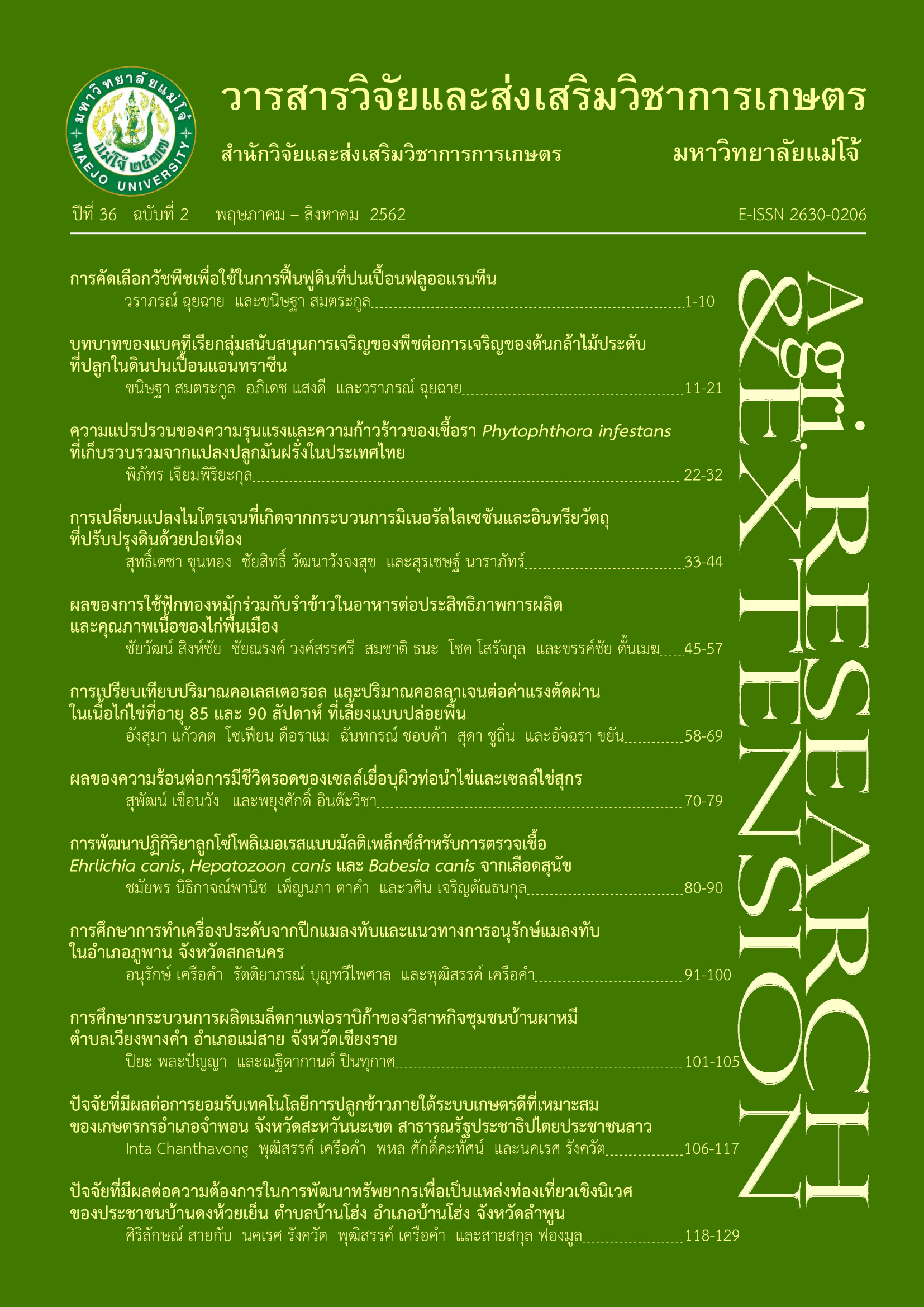บทบาทของแบคทีเรียกลุ่มสนับสนุนการเจริญของพืชต่อการเจริญของต้นกล้าไม้ประดับ ที่ปลูกในดินปนเปื้อนแอนทราซีน
คำสำคัญ:
แบคทีเรียกลุ่มสนับสนุนการเจริญเติบโตของพืช, ไม้ประดับ, แอนทราซีนบทคัดย่อ
การศึกษานี้มีวัตถุประสงค์เพื่อทดสอบความสามารถของแบคทีเรียกลุ่มสนับสนุนการเจริญเติบโตของพืช Paenibacillus sp. BSR1-1, Streptomyces sp. SRF1, Streptomyces sp. St1 และ Streptomyces sp. St8 ต่อการกระตุ้นการเจริญเติบโตของไม้ประดับ ได้แก่ เทียนดอก (I. balsamina L.) ดาวเรือง (T. erecta L.) และปอเทือง (C. juncea L.) ซึ่งปลูกในดิน ที่ปนเปื้อนแอนทราซีนที่ระดับความเข้มข้น 200 มก./กก. ผลการศึกษาพบว่าเทียนดอก ดาวเรือง และปอเทือง เจริญเติบโตได้ตามปกติในสภาวะที่ไม่ได้รับหัวเชื้อแบคทีเรียทั้งในดินที่ไม่ปนเปื้อนและปนเปื้อนแอนทราซีน การใช้หัวเชื้อแบคทีเรียทั้งสี่ชนิดไม่กระตุ้นการเจริญเติบโตของยอดและรากของเทียนดอก ดาวเรือง และปอเทือง ไม่ว่าจะปลูกในดินที่ไม่ปนเปื้อนหรือปนเปื้อน ก็ตาม การใช้หัวเชื้อแบคทีเรียกลับมีแนวโน้มส่งผลเสีย ที่แตกต่างกันต่อการเจริญเติบโตของพืช เช่น Streptomyces sp. SRF1 ทำให้ความยาวยอดและน้ำหนักของยอดเทียนดอกที่ปลูกในดินที่ไม่ปนเปื้อนลดลง และทำให้เมล็ดเทียนดอกไม่งอกเมื่อปลูกในดินที่ปนเปื้อนแอนทราซีน Paenibacillus sp. BSR1-1 ทำให้ความยาวยอดและน้ำหนักสดของยอด ความยาวรากและน้ำหนักสดของรากปอเทืองที่ปลูกในดินที่ปนเปื้อนแอนทราซีนต่ำกว่าปอเทืองที่ปลูกในสภาวะที่ไม่ได้รับหัวเชื้อแบคทีเรีย ส่วน Streptomyces sp. St1 และ Streptomyces sp. St8 ทำให้ความยาวยอดของดาวเรืองที่ปลูกในดินที่ปนเปื้อนแอนทราซีนสั้นกว่าดาวเรืองที่ปลูกในดินที่ปนเปื้อนแต่ไม่ได้รับหัวเชื้อแบคทีเรีย
เอกสารอ้างอิง
Ahmad, F., I. Ahmad and M.S. Khan. 2008. Screening of free-living rhizospheric bacteria for their multiple plant growth promoting activities. Microbiol. Res. 163: 178-181.
Ahammed, G.J., H.L. Yuan, J.O. Ogweno, Y.H. Zhou, X.J. Xia, W.H. Mao, K. Shi and J.Q. Yu. 2012. Brassinosteroid alleviates phenanthrene and pyrene phytotoxicity by increasing detoxification activity and photosynthesis in tomato. Chemosphere 86: 546-555.
Cardinale, M., S. Ratering, C. Suarez, A.M. Zapata Montoya, R. Geissler-Plaum and S. Schnell. 2015. Paradox of plant growth promotion potential of rhizobacteria and their actual promotion effect on growth of barley (Hordeum vulgare L.) under salt stress. Microbiol. Res. 181: 22-32.
Chen, X., X. Liu, X. Zhang, L. Cao and X. Hu. 2017. Phytoremediation effect of Scirpus triqueter inoculated plant-growth-promoting bacteria (PGPB) on different fractions of pyrene and Ni in co-contaminated soils. J. Harz. Mater. 325: 319-326.
Chouychai, W., T. Paemsom, C. Pobsuwan, K. Somtrakoon and H. Lee. 2016. Effect of Indole-3-acetic acid producing bacteria on phytoremediation of soil contaminated with phenanthrene and anthracene by mungbean. Environment Asia 9(2): 128-133.
Cristaldi, A., G.O. Conti, E.H. Jho, P. Zuccarello, A. Grasso, C. Copat and M. Ferrante. 2017. Phytoremediation of contaminated soils by heavy metals and PAHs. A brief review. Environmental Technology and Innovation 8: 309-326.
Delshadi, S., M. Ebrahimi and E. Shirmohammadi. 2017. Influence of plant-growth-promoting bacteria on germination, growth and nutrients’ uptake of Onobrychis sativa L. under drought stress. J. Plant Interact. 12(1): 200-208.
Grobelak, A., A. Napora and M. Kacprzak. 2015. Using plant growth-promoting rhizobacteria (PGPR) to improve plant growth. Ecol. Eng. 84: 22-28.
Hou, J., W. Liu, B. Wang, Q. Wang, Y. Luo and A.E. Franks. 2015. PGPR enhanced phytoremediation of petroleum contaminated soil and rhizosphere microbial community response. Chemosphere 138: 592-598.
Naik, P.R., G. Raman, K.B. Narayanan and N. Sakthivel. 2008. Assessment of genetic and functional diversity of phosphate solubilizing fluorescent pseudomonads isolated from rhizospheric soil. BMC Microbiol. 8: 230.
Rengarajan, T., P. Rajendran, N. Nandakumar, B. Lokeshkumar, P. Rajendran and I. Nishigaki. 2015. Exposure to polycyclic aromatic hydrocarbons with special focus on cancer. Asian Pac. J. Trop. Med. 5: 182-189.
Somtrakoon, K. and W. Chouychai. 2013. Phytotoxicity of single and combined polycyclic aromatic hydrocarbons toward economic crops. Russ. J. Plant Physl. 60: 139-148.
Spaepen, S., J. Vanderleyden and R. Remans. 2007. Indole-3-acetic acid in microbial and microorganism-plant signaling. FEMS Microbiol. Rev. 31: 425-448.
Wang, L., B. Ji, Y. Hu, R. Liu and W. Sun. 2017. A review on in situ phytoremediation of mine tailings. Chemosphere 184: 594-600.
ดาวน์โหลด
เผยแพร่แล้ว
รูปแบบการอ้างอิง
ฉบับ
ประเภทบทความ
สัญญาอนุญาต

อนุญาตภายใต้เงื่อนไข Creative Commons Attribution-NonCommercial-NoDerivatives 4.0 International License.
บทความนี้ได้รับการเผยแพร่ภายใต้สัญญาอนุญาต Creative Commons Attribution-NonCommercial-NoDerivatives 4.0 International (CC BY-NC-ND 4.0) ซึ่งอนุญาตให้ผู้อื่นสามารถแชร์บทความได้โดยให้เครดิตผู้เขียนและห้ามนำไปใช้เพื่อการค้าหรือดัดแปลง หากต้องการใช้งานซ้ำในลักษณะอื่น ๆ หรือการเผยแพร่ซ้ำ จำเป็นต้องได้รับอนุญาตจากวารสาร





